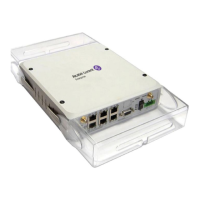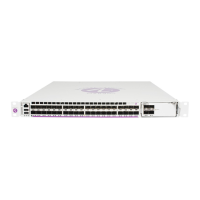VRRP
7705 SAR OS Router Configuration Guide 251
The route-unknown command configures a priority control event that defines a link between the
VRRP priority control policy and the RTM. The RTM registers the specified route prefix as monitored
by the policy. If any change (add, delete, new next hop) occurs relative to the prefix, the policy is
notified and takes proper action according to the priority event definition. If the route prefix exists and
is active in the routing table according to the conditions defined, the event is in the cleared state. If the
route prefix is removed, becomes inactive, or fails to meet the event criteria, the event is in the set state.
Up to 32 route-unknown events can be configured.
The route-unknown command can reference any valid IP address mask-length pair. The IP address
and associated mask length define a unique IP router prefix. The dynamic monitoring of the route
prefix results in one of the following event operational states:
An existing route prefix in the RTM must be active (used by the IP forwarding engine) to clear the
event operational state. It can be less specific (the defined prefix can be contained in a larger prefix
according to CIDR techniques) if the event has the less-specific statement defined. The less-specific
route that incorporates the router prefix can be the default route (0.0.0.0) if the less-specific
allow-default statement is defined. The matching prefix can be required to have a specific next-hop
IP address if defined by the event next-hop command. Finally, the source of the RTM prefix can be
required to be one of the dynamic routing protocols or be statically defined if defined by the event
protocol command. If an RTM prefix is not found that matches all the above criteria (if defined in the
event control commands), the event is considered to be set. If a matching prefix is found in the RTM,
the event is considered to be cleared.
If an event transitions from clear to set, the set is processed immediately and must be reflected in the
associated virtual router instance in-use priority value. As the event transitions from clear to set, the
hold-set timer is started. This timer prevents the event from clearing until it expires, damping the effect
of event flapping. If the event clears and becomes set again before the hold-set timer expires, the timer
is reset to the hold-set value, extending the time before another clear can take effect.
Route Unknown
Operational State
Description
Set – non-existent The route does not exist in the route table
Set – inactive The route exists in the route table but is not being used
Set – wrong next hop The route exists in the route table but does not meet the next-hop
requirements
Set – wrong protocol The route exists in the route table but does not meet the protocol
requirements
Set – less specific found The route exists in the route table but does is not an exact match and
does not meet any less-specific requirements
Set – default best match The route exists in the route table as the default route but the default
route is not allowed for route matching
Cleared – less specific found A less-specific route exists in the route table and meets all criteria
including the less-specific requirements
Cleared – found The route exists in the route table manager and meets all criteria

